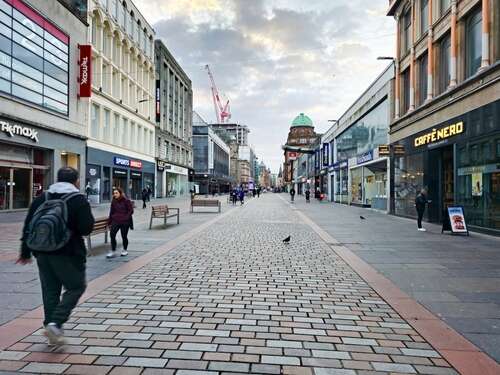
The future of Glasgow’s iconic Golden Z district, encompassing Argyle, Buchanan and Sauchiehall Streets, is set for a transformation following the approval of the ‘Vision and Delivery Plan’ by the Glasgow City Council committee last Thursday.

Traditionally the heart of Glasgow’s retail core and a vital contributor to the city’s economy, the Vision and Delivery Plan aims to make the Golden Z more resilient, diverse and environmentally conscious. It charts a course for targeted intervention and investment by both public and private sectors, with a focus on supporting recovery and long-term sustainability.
The redevelopment of three key areas has been identified as pivotal to the Golden Z’s success: the former ABC/Jumpin Jacks site near the Glasgow School of Art, the Sauchiehall Street zone encompassing the former BHS, Watt Bros and former Victoria’s nightclub gap site, and the vicinity around the vacant TJ Hughes site near Trongate.
This plan seeks to respond to the challenges and opportunities presented by the post-pandemic landscape of the city centre. It is the result of a collaborative effort involving Glasgow City Council and a team of consultants, including Stantec (UK), Threesixty Architecture and Kevin Murray Associates. Engaging with landowners, businesses, institutions, agencies, residents, and visitors, the plan draws on their insights to reimagine the Golden Z.
Preserving Glasgow’s Legacy: Inside the Golden Z
A report commissioned by the Glasgow City Council explains the plan to rejuvenate and transform the Golden Z in greater detail. The report recognises that the Golden Z is not just a shopping destination; it’s a multifaceted organism deeply intertwined with the city’s identity, community and well-being.
Glasgow aspires to lead the way in tackling climate risk; double its city centre’s population by 2035; and ensure the city centre is inclusive.
The report acknowledges the seismic shifts in how we shop and work, accelerated by the Covid-19 pandemic. Traditional retailing is undergoing a revolution, with shopping centres evolving into mixed-use destinations.
The report takes inspiration from the 1983 Gordon Cullen Blueprint for Glasgow City Centre. While not all elements of this blueprint have been realised, its influence is clear in the city’s development over the past four decades. Collaborations between the public and private sectors have played a pivotal role in bringing this vision to life.
The Golden Z has long been tied to its role as a retail hub. However, as the retail landscape evolves, the report highlights the need for a greater mix of uses and increased upper-level inhabitation to ensure the health of the city centre as a whole. Sauchiehall Street and Argyle Street, in particular, present both challenges and opportunities for revitalisation.
The report stresses the importance of leveraging the Golden Z’s built heritage and urban quality to make the city centre relevant to all generations. Authenticity, combined with quality of life improvements, will be crucial in attracting residents, businesses, and tourists and encouraging a post-pandemic return to work.
A sustainable future
Glasgow’s ambition to become carbon neutral by 2030 aligns with the principles embedded in this vision for the Golden Z. The plan calls for increased green spaces and connections to existing green spaces, promoting urban living, cooling, biodiversity and rainwater attenuation.
Addressing long-term vacancies and inactivity in key areas, such as the BHS and Victoria’s gap sites, is crucial to the Golden Z’s future. The report suggests that Glasgow City Council should directly intervene, utilising its statutory powers to collaborate with the private sector and unlock these vital sites.
[Read more: Could trams return to the streets of Glasgow?]






